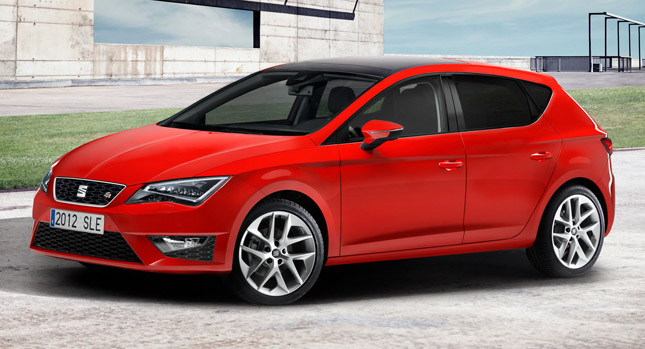The new, third generation of the Seat Leon was officially unveiled today, some two-and-a-half months prior to its Paris Motor Show debut in front of the public in late September.
Seen here in five-door trim, the new Leon will also be available in a sportier looking three-door hatchback body style as well as an estate variant, with all three models to be launched into the market by next fall.
The new Leon sports a sharper look with more creases that brings to mind the IBE Concept as well as the Ibiza. Due to the fact that there will be a three-door Leon, Seat has replaced the current model’s hidden rear door grips with conventional handles mounted on the doors.
 The Leon is also the first Seat car to wear the company’s newly designed badge, which will eventually be used on all models.
The Leon is also the first Seat car to wear the company’s newly designed badge, which will eventually be used on all models.
Inside, the Leon Mk3 features a contemporary design with an instrument panel that looks very similar to the one found in the latest Audi A3. Seat officials say the materials, finish and attention to details are “at least as good as you can find in the segment above.”
“The design of the dashboard respects our new interior philosophy, with a strong driver orientation,” said Alejandro Mesonero-Romanos, Seat’s head designer. “This enhances the ergonomics while giving the design an attractive, sporty feeling. The whole has been designed so the new Leon and its driver feel as one.”
Among other available features is a new infotainment system that comes with a 5.8-inch touch screen with three-dimensional graphics in high definition, iPod connectivity, an optional DAB tuner, and voice recognition.
Hiding under the very Ibiza-like exterior styling is the VW Group’s new modular MQB platform, which underpins the Audi A3 and will also feature in the next VW Golf and several other models.
The Leon measures 4,263mm long that makes it around five centimeters shorter than the outgoing model, but the wheelbase is up by almost six centimeters at 2636mm, something that should improve its interior space. According to the Spanish automaker, the luggage compartment has a volume of 380 litres, around 40 litres more than the preceding model.
In addition, Seat says that thanks to advanced construction techniques and the use of lightweight materials in the body’s manufacture, the car’s overall weight has been reduced by 90 kilograms (just under 200 pounds) compared to the second generation model.
The new Leon will be offered with the usual mix of turbocharged TSI petrol and TDI diesel engines we find in other models of the VW Group. All engines feature direct injection and turbocharging with Seat claiming that compared to their respective predecessors, their fuel consumption is down by up to 22 percent.
At launch, the Leon will be offered with a 1.6-liter turbo diesel generating 104hp (105PS) and 250Nm (184 lb.ft) of torque that returns 4.0lt/100km (70.6mpg UK or 58.8mpg US) with CO2 emissions of just 99g/km. There’s also a 2.0-liter turbo diesel with 148hp (150PS) and 320Nm (236 lb.ft).
Early next year will see the arrival of several gasoline engines including the 1.2-liter TSI in 85hp (86PS) and 104hp (105PS) flavors, the 1.4-liter TSI with 120hp (122PS) and a 1.8-liter TSI producing 178hp (180PS).
The diesel line-up will be enhanced with a 1.6-liter TDI producing 89hp (90PS) and the range-topping 2.0-liter TDI with 181hp (184PS) and a maximum torque of 380 Nm (280 lb.ft).
Depending on the engine, transmission options include five- and six-speed manual gearboxes and six- and seven-speed DSG dual-clutch gearboxes.
Seat said that while the front suspension features a MacPherson front axle with sub-frame on all models, the rear uses a torsion beam for engines up to 148hp (150PS) and a more sophisticated multi-link construction for the more powerful variants.
The first examples of the Leon 5d will begin arriving in European dealerships this fall.
VIDEO
PHOTO GALLERY





























